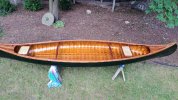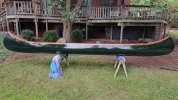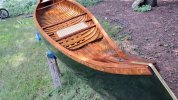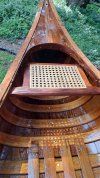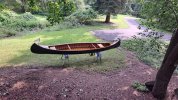Worth: So yeah, I used Dacron on this canoe. Easy decision: this is a Veazie/Morris, so it has thicker ribs which along with the long decks and the ash I used for the rails I figured would make it weigh more than a typical canoe. Dacron would save weight, so decision made. Unfortunately the canoe came to me with fiberglass so I've no way to tell how much it used to weigh with canvas, but it now weighs about 76# with the floor rack.
The Dacron I used is Ceconite C-101-4.
https://www.conaircraft.com/fabrics
So it's a little bit lighter weight than the material I used for the previous canoe (the Tremblay), which was 3.7oz stuff I had gotten from Larry at Geodesic Boats. Unfortunately Larry was on vacation when I needed the Dacron so I ordered it from someplace I found via Google. I saw in your writeup that you used the heavier material, and I think I remember you noting that you needed to use a higher temperature to shrink the material due to its thickness. This scared me off a bit. My experience with both the 3.7oz (and 3.4oz as well) was that it was relatively easy to shrink so I stayed with it the thinner stuff.
So some observations:
1. Dacron is so thin that I'm afraid of using a motorized sander for fear that I might break through whatever I'm sanding and damage the dacron. This poses a problem with the primer I used which tends to go on thicker than paint. Thus I didn't smooth it enough before I started painting. My bad.
2. I was lucky when covering the Tremblay as the outside of the hull was in excellent shape, and the painted dacron looked nice and smooth. This Veazie however had some sizeable dings and dents due to age, usage, and fiberglass removal, and while I did spent quite some time using fairing material to fill in the low spots, the resulting finish isn't as smooth as the Tremblay's. This would have been unnoticable if I had used canvas, but the thinness of the Dacron plus paint doesn't allow many imperfections to hide. Maybe the thicker stuff you used would work better???
3. One nice feature of painted Dacron is that trimming the area by the rib tips is way easier than trimming canvas: it cuts far easier than painted & filled canvas (if you use good scissors).
4. There's another nice feature of using Dacron on canoe with rail caps: Since the painted Dacron is very thin and easily bent I found it easy to trim the Dacron edge 1/2"
above the rib tips and fold the material on top of the rails where it was held down by the rail caps. This meant there was no raggedy trimmed painted Dacron visible in the crack between the rail caps & thin rail sides.
